Computational Fluid Dynamics Modelling and Analysis Approach for Estimating Internal Short-Circuiting in Clearwells
Abstract
:1. Introduction
2. Materials and Methods
2.1. Developing, Verifying, and Simulating the CFD Model
2.2. Developing an Internal Short-Circuiting Estimation Method
- Step 1: Simulation of the verified CFD model
- Step 2: Selection sections in each channel zone
- Step 3: Calculating the average vertical velocity of each element
- Step 4: Converting element velocity data into a frequency-of-occurrence diagram
- Step 5: Calculating ISI for each section
- Step 6: Plotting the ISI diagram
3. Results
3.1. CFD Model Verification
3.2. Determining an ISI
3.3. Estimating the Effect of the LW Ratio on T10/T with ISEM
3.3.1. Estimating Short-Circuiting in Low LW Ratio
3.3.2. Investigating Why the T10/T Value Increases as LW Ratio Increases
3.4. Estimating the Effect of Shape on the Pattern of LW Ratio and T10/T
3.4.1. Pattern of LW Ratio and T10/T with Different Shape Ratio
3.4.2. Investigating the Effect of Shape on the Pattern of the LW Ratio and T10/T
4. Discussion
5. Conclusions
Author Contributions
Funding
Institutional Review Board Statement
Informed Consent Statement
Conflicts of Interest
References
- American Water Works Association. Water Quality and Treatment: A Handbook of Community Water Supplies; American Water Works Association: Denver, CO, USA, 1990. [Google Scholar]
- Marske, D.M.; Boyle, J.D. Chlorine contact chamber design—A field evaluation. Water Sew. Work. 1973, 120, 70–71. [Google Scholar]
- Falconer, R.A.; Tebbutt, T.H.Y. A theoretical and hydraulic model study of a chlorine contact tank. Proc. Inst. Civ. Eng. Part 2 Res. Theory 1986, 81, 255–276. [Google Scholar]
- Stamou, A.I. Verification and application of a mathematical model for the assessment of the effect of guiding walls on the hydraulic efficiency of chlorination tanks. J. Hydroinform. 2002, 4, 245–254. [Google Scholar] [CrossRef] [Green Version]
- Stambolieva, A. Methods for the Design of Chlorine Contactors for Drinking Water Treatment. In Proceedings of the 1993 AWWA Annual Conference, San Antonio, TX, USA, 6–10 June 1993. [Google Scholar]
- Hannoun, I.A.; Boulos, F. Optimizing distribution storage water quality: A hydrodynamic approach. J. Am. Water Work. Assoc. 1998, 90, 77–87. [Google Scholar] [CrossRef]
- Wang, H.; Falconer, R.A. Simulating disinfection process in chlorine contact tanks using various turbulence models and high-order accurate difference schemes. Water Res. 1998, 32, 1529–1543. [Google Scholar] [CrossRef]
- Corzes, G.F.; Hagstrom, J.P.; Clark, M.M.; Ducoste, J.; Burns, C. Improving Clearwell Design for CT Compliance; AWWARF and AWWA: Denver, CO, USA, 1999. [Google Scholar]
- Huang, T.H.; Brouckaert, C.J. Application of computational fluid dynamics modeling to an ozone contactor. Water SA 2004, 30, 51–56. [Google Scholar] [CrossRef] [Green Version]
- Hofman, J.; Wind, D.; Wols, B.; Uijttewaal, W. The Use of CFD Modeling to Determine the Influence of Residence Time Distribution on the Disinfection of Drinking Water in Ozone Contactors. In Proceedings of the COMSOL Conference, Napoli, Italy, 23–24 October 2007. [Google Scholar]
- Wols, B.A.; Uijttewaal, W.S.J.; Rietveld, L.C.; Stelling, G.S.; van Dijk, J.C.; Hofman, J.A.M.H. Residence time distributions in ozone contactors. Ozone Sci. Eng. 2008, 30, 49–57. [Google Scholar] [CrossRef]
- Kim, D.; Kim, D.I.; Kim, J.H.; Stoesser, T. Large eddy simulation of flow and tracer transport in multichamber ozone contactors. J. Environ. Eng. 2010, 136, 22–31. [Google Scholar] [CrossRef] [Green Version]
- Amini, R.; Taghipour, R.; Mirgolbabaei, H. Numerical assessment of hydrodynamic characteristics in chlorine contact tank. Int. J. Numer. Methods Fluids 2011, 67, 885–898. [Google Scholar] [CrossRef]
- Zhang, J.; Tejada-Martinez, A.E.; Zhang, Q. Hydraulic efficiency in RANS of the flow in multi-chambered ozone contactors. J. Hydraul. Eng. 2013, 139, 1150–1157. [Google Scholar] [CrossRef]
- Chiu, K.; Lyn, D.A.; Savoye, P.; Blatchley, E.R., III. Integrated UV disinfection model based on particle tracking. ASCE J. Environ. Eng. 1999, 125, 7–16. [Google Scholar] [CrossRef]
- Lyn, D.A.; Chiu, K.; Blatchley, E.R. Numerical modeling of flow and disinfection in UV disinfection channels. ASCE J. Environ. Eng. 1999, 125, 17–26. [Google Scholar] [CrossRef]
- Do-Quang, Z.; Cockx, A.; Line, A.; Roustan, M. Computational fluid dynamics applied to water and wastewater treatment facility modeling. Environ. Eng. Policy 1999, 1, 137–147. [Google Scholar] [CrossRef]
- Greene, D.J.; Farouk, B.; Haas, C.N. CFD design approach for chlorine disinfection processes. J. Am. Water Work. Assoc. 2004, 96, 138–150. [Google Scholar] [CrossRef]
- Zhang, G.; Lin, B.; Falconer, R.A. Modelling disinfection by-products in contact tanks. J. Hydroinform. 2000, 2, 123–132. [Google Scholar] [CrossRef] [Green Version]
- Bolanos, E.Q.; Ocampo, J.T.; Rodriguez, L.C. Applicability of computational fluid dynamics to simulate ozonation processes. Ing. Desarro. 2008, 24, 97–116. [Google Scholar]
- Bartrand, T.A.; Farouk, B. Countercurrent gas/liquid flow and mixing: Implications for water disinfection. Int. J. Multiph. Flow 2009, 35, 171–184. [Google Scholar] [CrossRef]
- Wols, B.A.; Hofman, J.A.M.H.; Uijttewaal, W.S.J.; Rietveld, L.C.; van Dijk, J.D. Evaluation of different disinfection calculation methods using CFD. Environ. Model. Softw. 2010, 25, 573–582. [Google Scholar] [CrossRef]
- Talvy, S.; Debaste, F.; Martinelli, L.; Chauveheid, E.; Haut, B. Development of a tool, using CFD, for the assessment of the disinfection process by ozonation in industrial scale drinking water treatment plants. Chem. Eng. Sci. 2011, 66, 3185–3194. [Google Scholar] [CrossRef]
- Angeloudis, A.; Stoesser, T.; Gualtieri, C.; Falconer, R.A. Contact tank design impact on process performance. Environ. Model. Assess. 2016, 21, 563–576. [Google Scholar] [CrossRef] [Green Version]
- Wang, H.; Shao, X.; Falconer, R.A. Flow and transport simulation models for prediction of chlorine contact tank flow-through curves. Water Environ. Res. 2003, 75, 455–471. [Google Scholar] [CrossRef] [PubMed]
- Rauen, W.B.; Lin, B.; Falconer, R.A.; Teixeira, E.C. CFD and experimental model studies for water disinfection tanks with low Reynolds number flows. Chem. Eng. J. 2008, 137, 550–560. [Google Scholar] [CrossRef]
- Angeloudis, A.; Stoesser, T.; Falconer, R.A. Predicting the disinfection efficiency range in chlorine contact tanks through a CFD-based approach. Water Res. 2014, 60, 118–129. [Google Scholar] [CrossRef] [PubMed]
- Zhang, J.; Tejada-Martinez, A.E.; Zhang, Q.; Lei, H. Evaluating hydraulic and disinfection efficiencies of a full-scale ozone contactor using a RANS-based modeling framework. Water Res. 2014, 52, 155–167. [Google Scholar] [CrossRef]
- Demirel, E.; Aral, M.M. Unified analysis of multi-chamber contact tanks and mixing efficiency evaluation based on vorticity field. Part I: Hydrodynamic analysis. Water 2016, 8, 495. [Google Scholar] [CrossRef] [Green Version]
- Wu, J.; Xiao, H.; Paterson, E. Physics-informed machine learning approach for augmenting turbulence models: A comprehensive framework. Phys. Rev. Fluids 2018, 3, 074602. [Google Scholar] [CrossRef] [Green Version]
- Zhao, Y.; Akolekar, H.D.; Weatheritt, J.; Michelassi, V.; Sandberg, R.D. RANS turbulence model development using CFD-driven machin learning. J. Comput. Phys. 2020, 411, 109413. [Google Scholar] [CrossRef] [Green Version]
- Teixeria, E.D.; Siqueira, R.N. Performance assessment of hydraulic efficiency indexes. J. Environ. Eng. 2008, 134, 851–859. [Google Scholar] [CrossRef]
- Gualtieri, C. Discussion of “performance assessment of hydraulic efficiency indexes” by Edmilson Costa Teixeira and Renato do Nascimento Siqueira. J. Environ. Eng. 2010, 134, 851–859. [Google Scholar] [CrossRef]
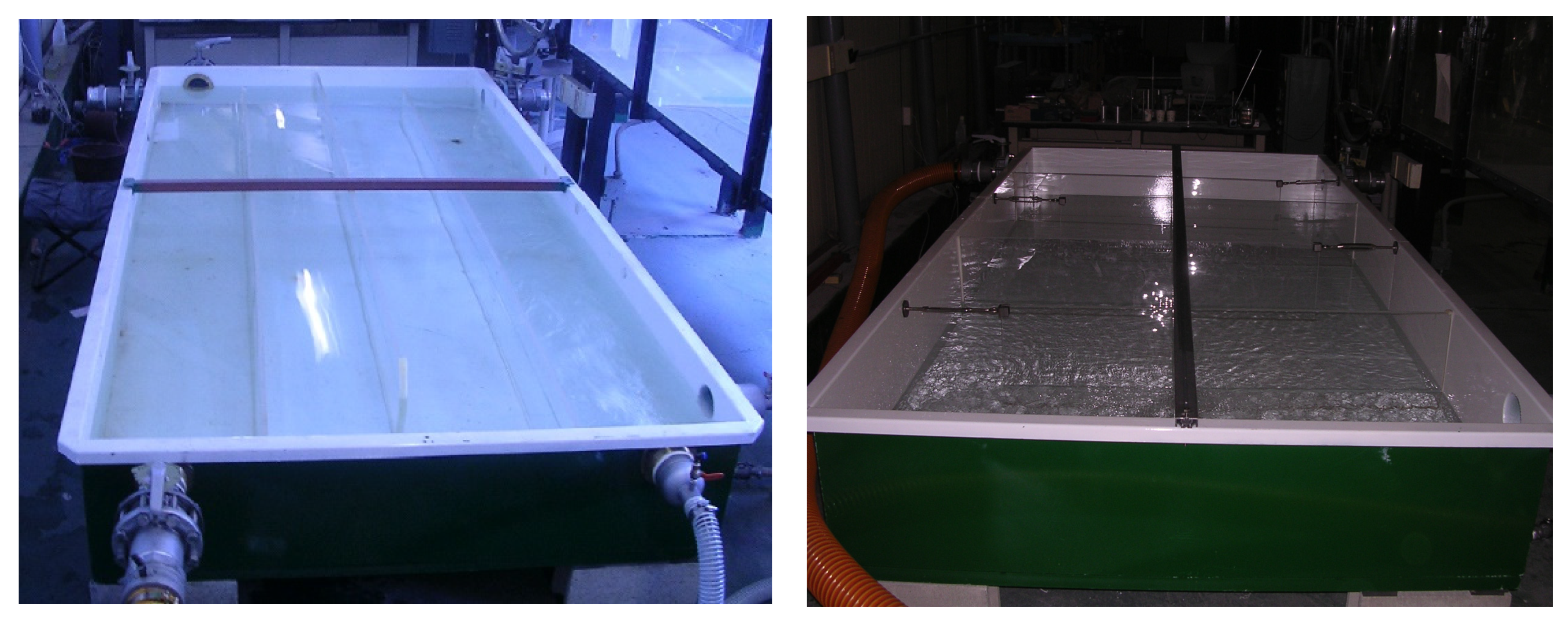

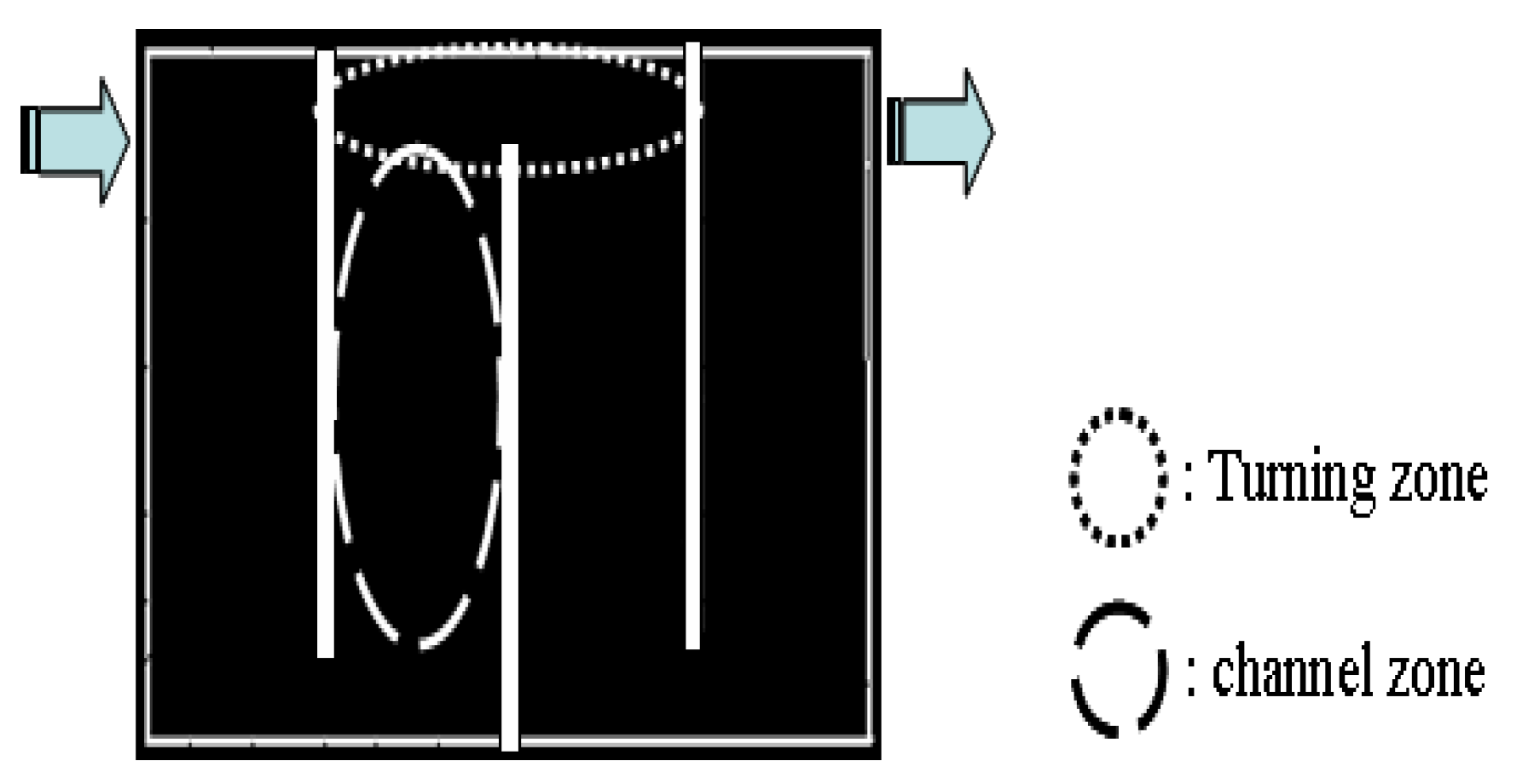
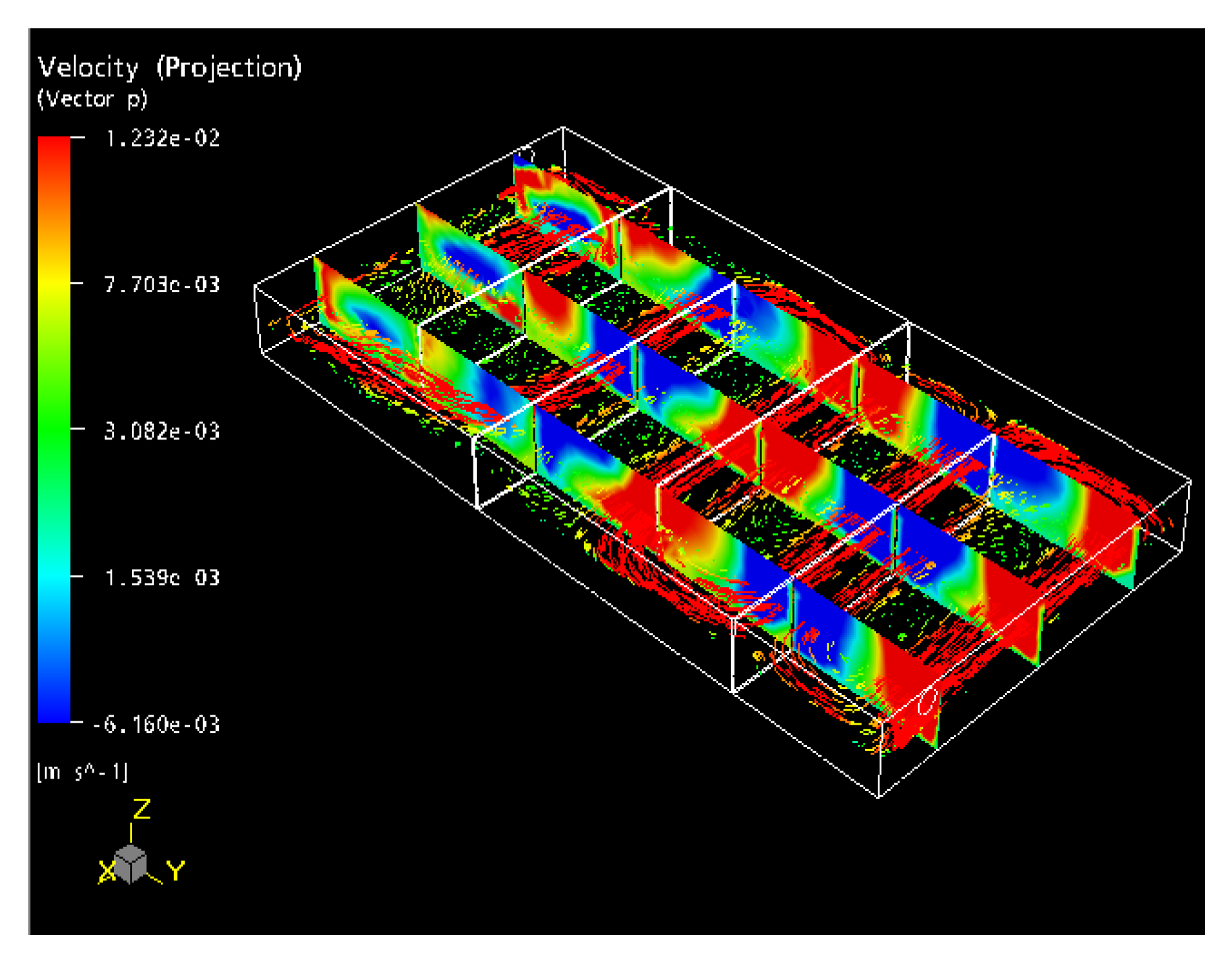
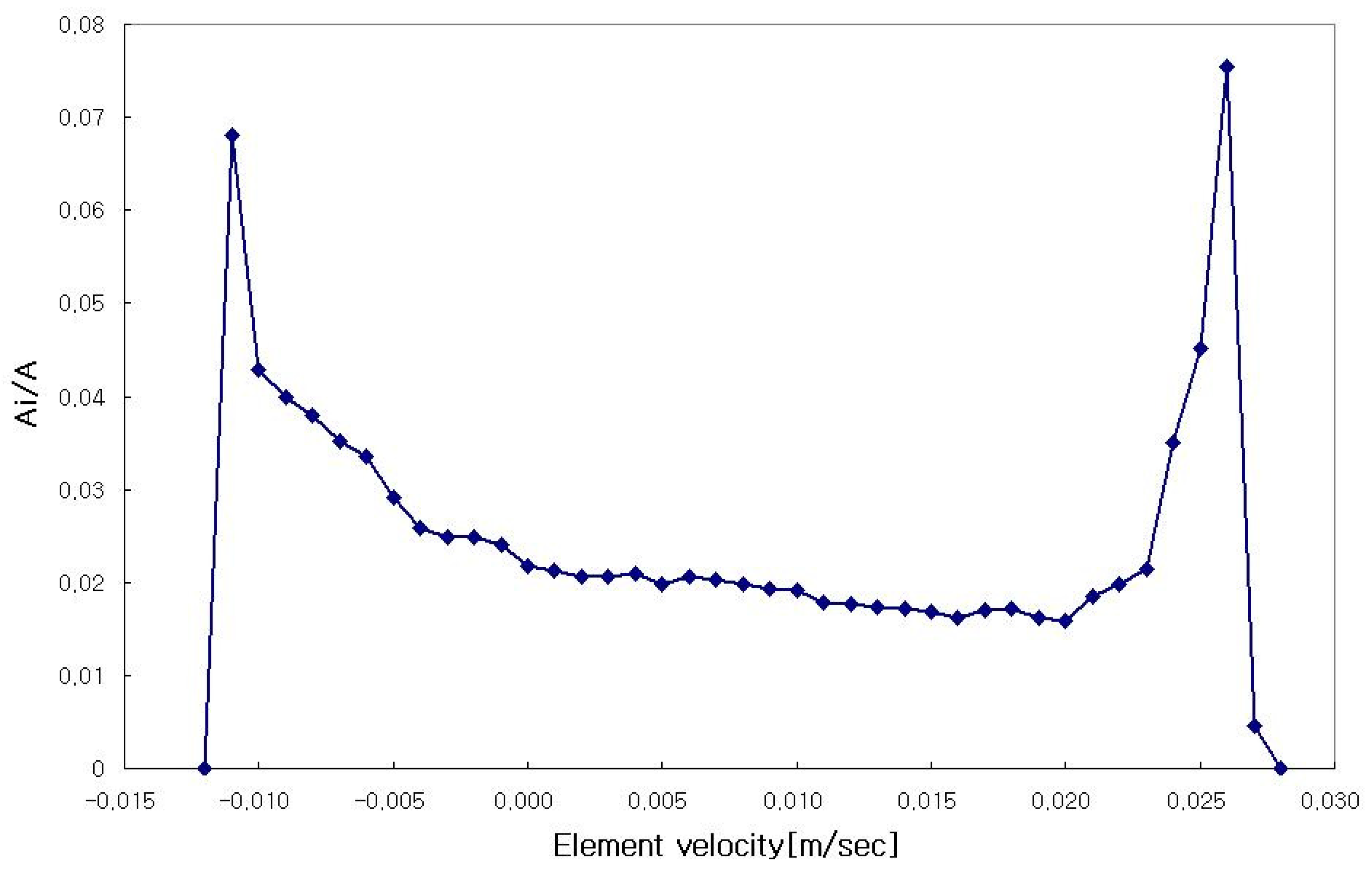


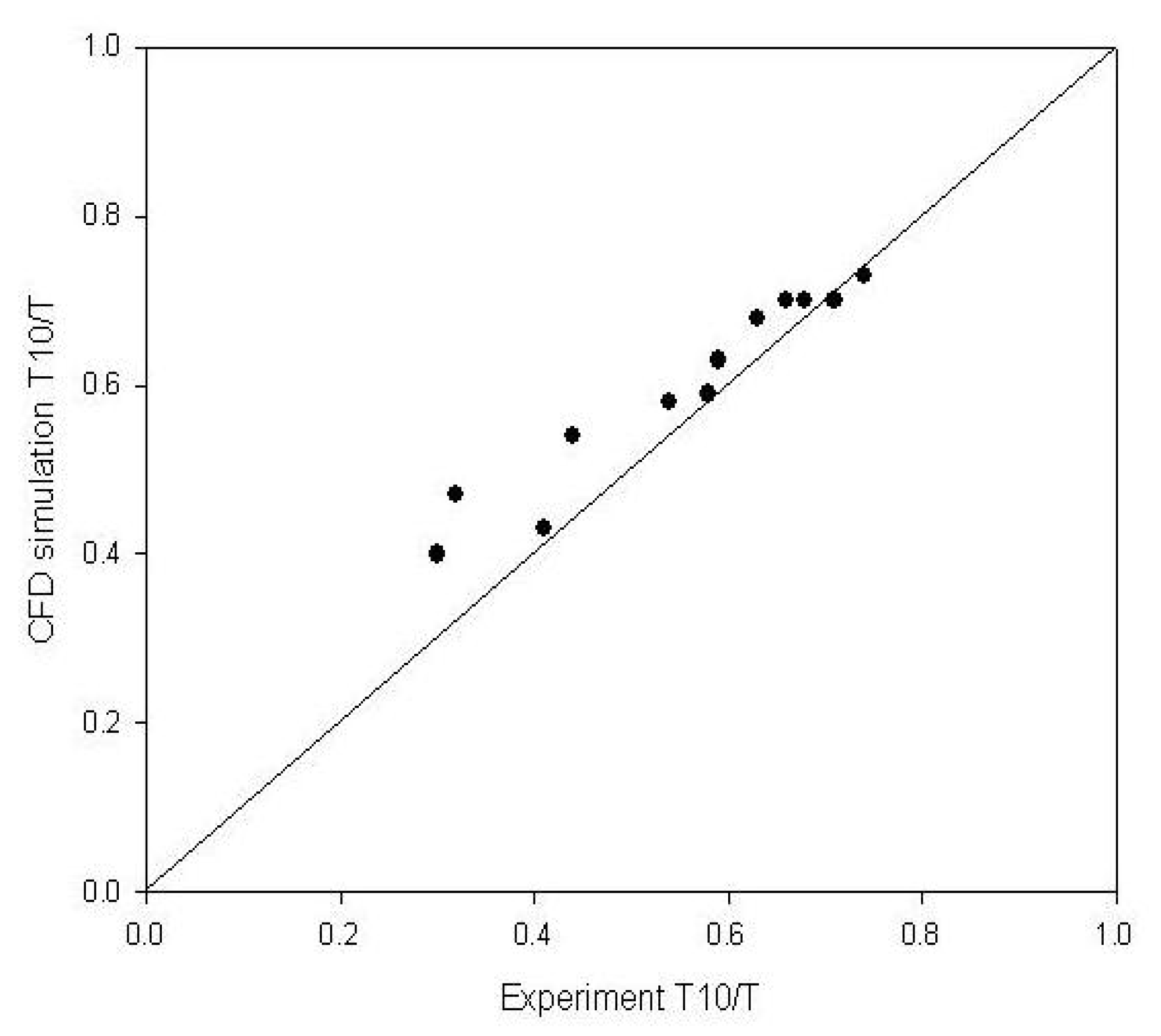
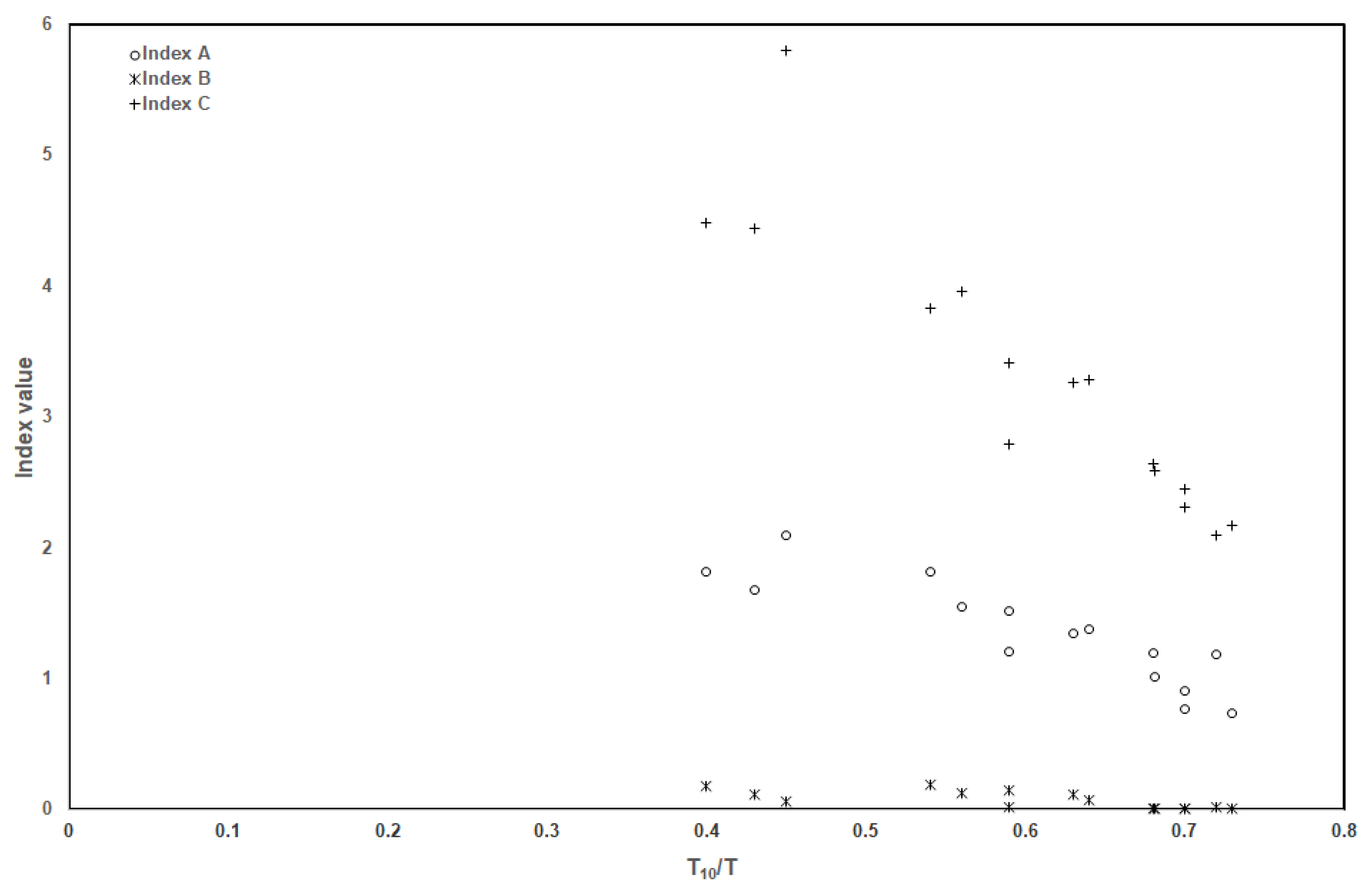
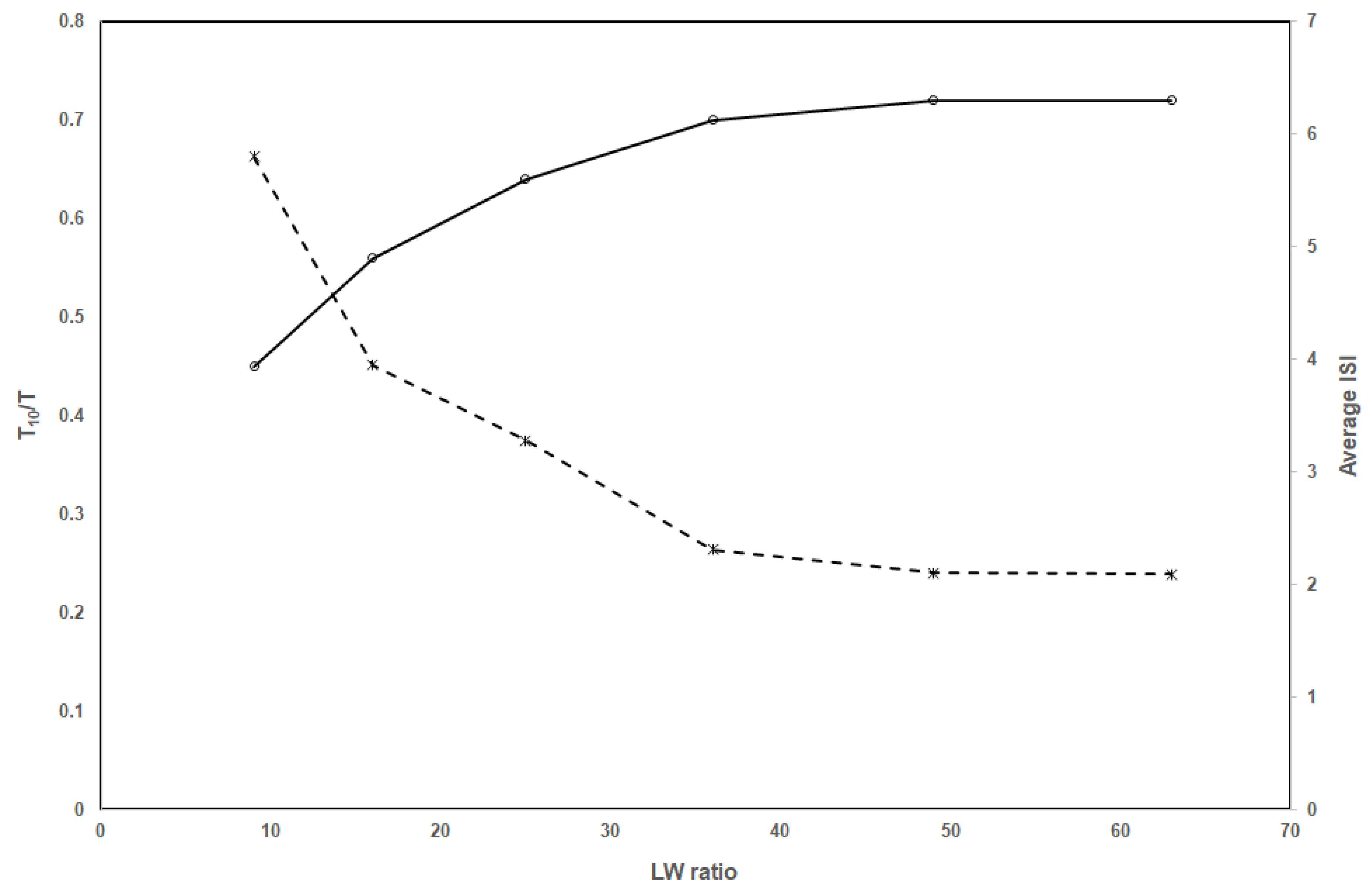
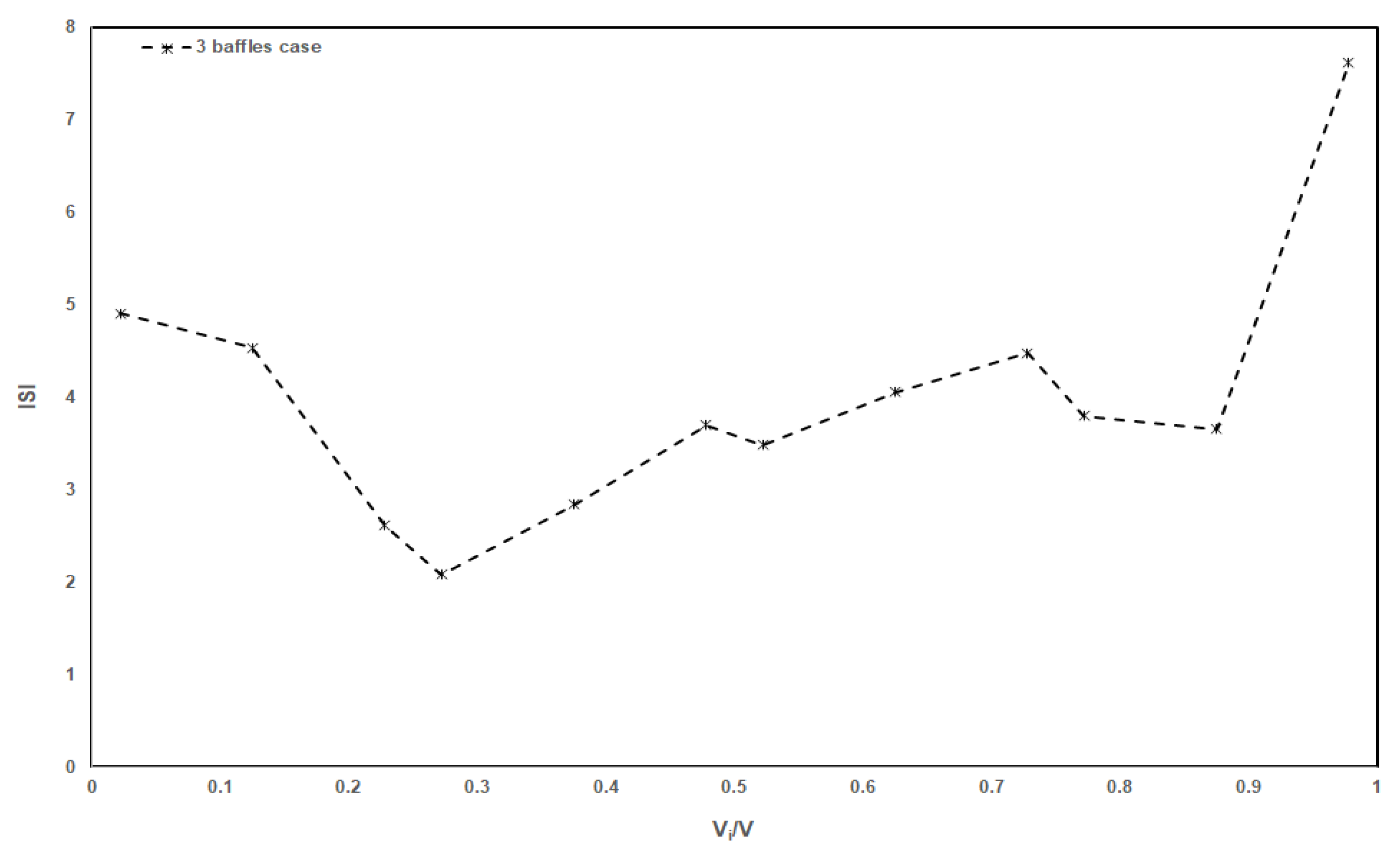
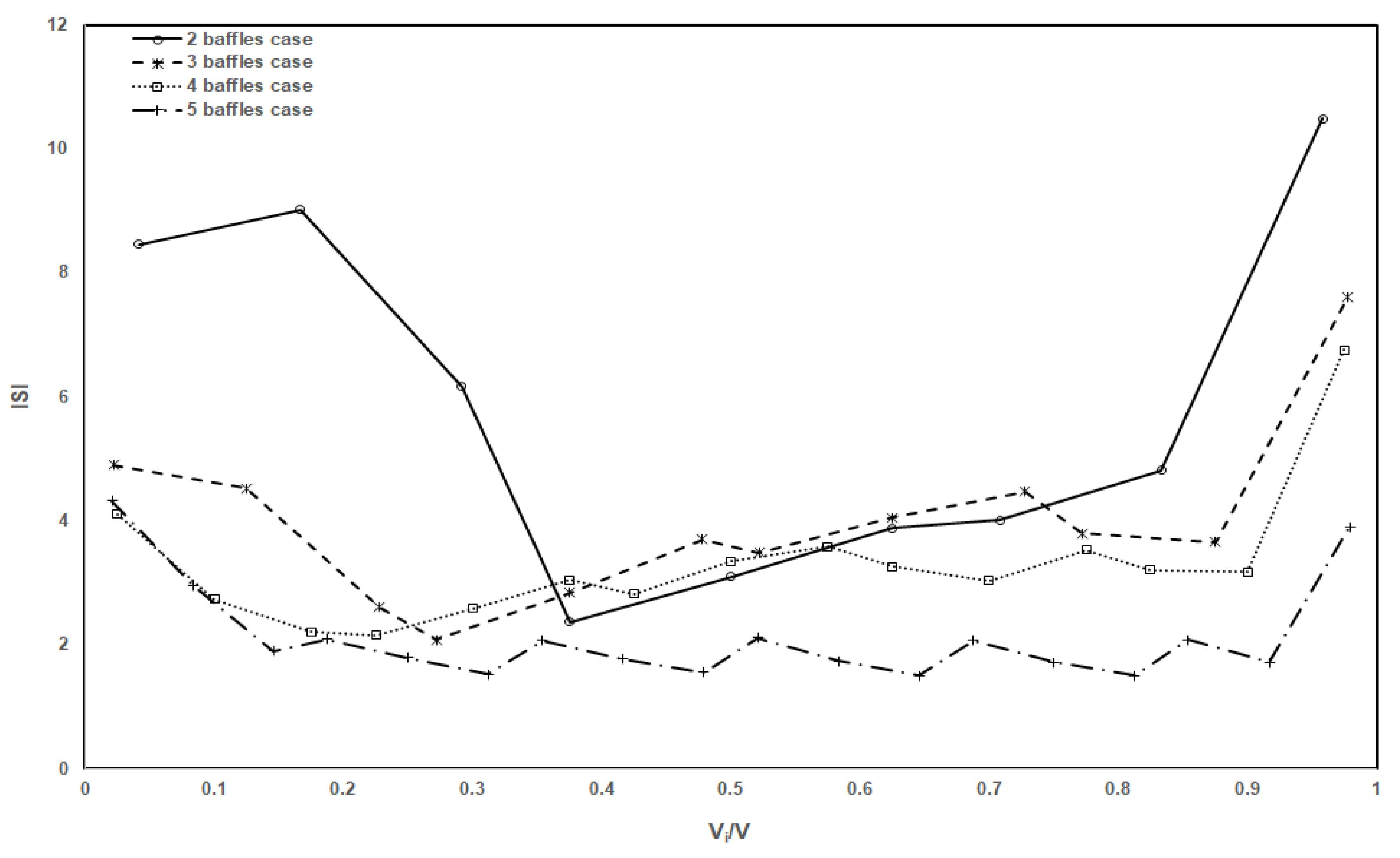
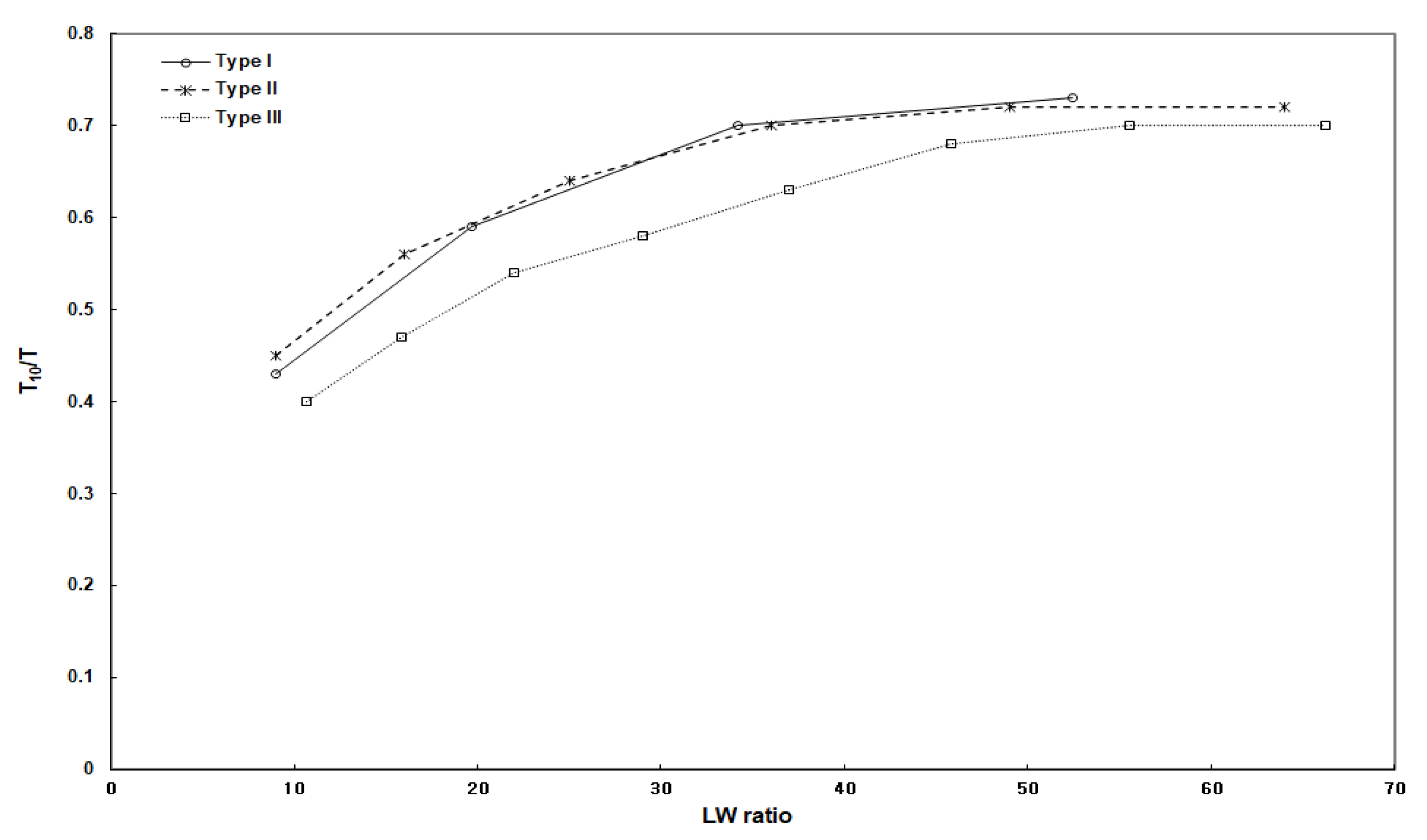

| Items | Condition | Items | Condition |
|---|---|---|---|
| Fluid | Pure water (25 °C) | Wall conditions | No-slip condition |
| Turbulence model | k–ε model | Condition of water surface | Free-slip condition |
| Heat transfer | Not considered | Mesh | Tetra mesh |
| Fluctuation of flow rate and water depth | None | Iteration no. | 50 times |
| Inlet flow direction | Perpendicular | Result reporting time step | 30 s |
| Pressure at outlet | 1 atm | Convergence condition | Target residual < 10−3 |
| Type | Number of Baffles | LW Ratio | Type | Number of Baffles | LW Ratio |
|---|---|---|---|---|---|
| Type I | 1 | 9 | Type II | 7 | 64 |
| 2 | 20 | Type III | 3 | 11 | |
| 3 | 34 | 4 | 16 | ||
| 4 | 52 | 5 | 22 | ||
| Type II | 2 | 9 | 6 | 29 | |
| 3 | 16 | 7 | 37 | ||
| 4 | 25 | 8 | 46 | ||
| 5 | 36 | 9 | 56 | ||
| 6 | 49 | 10 | 66 |
| Number of Baffles | LW Ratio | T10/T | Average ISI |
|---|---|---|---|
| 2 | 9 | 0.45 | 5.80 |
| 3 | 16 | 0.56 | 3.95 |
| 4 | 25 | 0.64 | 3.28 |
| 5 | 36 | 0.70 | 2.31 |
| 6 | 49 | 0.72 | 2.10 |
| 7 | 63 | 0.72 | 2.09 |
| Type | Shape Ratio | Number of Baffles | LW Ratio | T10/T | Average ISI |
|---|---|---|---|---|---|
| Type I | 0.5 | 3 | 34 | 0.70 | 2.45 |
| Type II | 1 | 4 | 25 | 0.64 | 3.28 |
| Type III | 2 | 7 | 37 | 0.59 | 3.42 |
Publisher’s Note: MDPI stays neutral with regard to jurisdictional claims in published maps and institutional affiliations. |
© 2021 by the authors. Licensee MDPI, Basel, Switzerland. This article is an open access article distributed under the terms and conditions of the Creative Commons Attribution (CC BY) license (https://creativecommons.org/licenses/by/4.0/).
Share and Cite
Shin, E.; Ryu, J.; Park, H. Computational Fluid Dynamics Modelling and Analysis Approach for Estimating Internal Short-Circuiting in Clearwells. Water 2021, 13, 1849. https://doi.org/10.3390/w13131849
Shin E, Ryu J, Park H. Computational Fluid Dynamics Modelling and Analysis Approach for Estimating Internal Short-Circuiting in Clearwells. Water. 2021; 13(13):1849. https://doi.org/10.3390/w13131849
Chicago/Turabian StyleShin, Eunher, Jewan Ryu, and Heekyung Park. 2021. "Computational Fluid Dynamics Modelling and Analysis Approach for Estimating Internal Short-Circuiting in Clearwells" Water 13, no. 13: 1849. https://doi.org/10.3390/w13131849
APA StyleShin, E., Ryu, J., & Park, H. (2021). Computational Fluid Dynamics Modelling and Analysis Approach for Estimating Internal Short-Circuiting in Clearwells. Water, 13(13), 1849. https://doi.org/10.3390/w13131849






